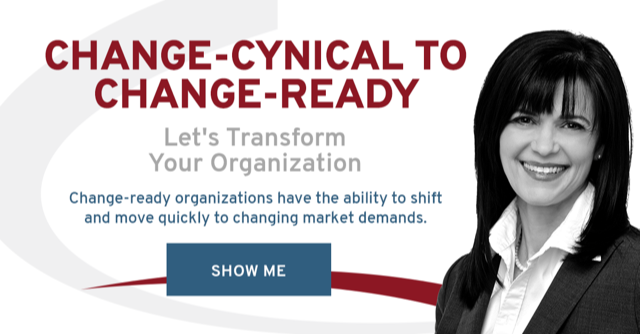Are your employees too tired to change?
Dr. Dawn-Marie Turner
“We need to be constantly changing.”
The need to be continuously evolving is a business necessity. The problem is most organizations are simply not set up for continuous change. Continuous change does not mean bombarding your employees with one change after another. This approach has led to a growing and costly problem—change fatigue.
Change fatigue is associated with increased stress, exhaustion, and decreased organizational commitment. In my book “Launch Lead Live”, I outline the importance of commitment to the success of your change efforts. Left unchecked change fatigue leads to burn out, and burned out employees won’t contribute to your organization.
Change fatigue can be described as passive resignation. It is this passive resignation that can make change fatigue more of problem than the “resistance to change” many leaders talk about.
Why? Because change fatigue means that you have neither the energy to defend the current state nor the energy to move through a change process.
The Impact of Change Fatigue on Your Business
Change fatigue can have a big impact on both your organization’s ability to change and its general operation.
The exhaustion that comes with change fatigue leads to a general sense of apathy toward change. One manager described to me how his employees just didn’t seem to think when performing their job. When I asked about it, he described employees who did what they were asked, but that’s all. They just didn’t seem to care and there was general sloppiness. When apathy sets in, you begin to lose the productivity, the innovation, and creativity of the people affected.
As the change fatigue continues employees disengage. Disengagement is when your employees come to work, but their commitment, contribution, and value doesn’t. An engaged employee comes to work asking, “How can I make a difference?” or, “How can I contribute?”
A disengaged employee comes to work asking, “What will I get out of it?” Or, “Is it time to go home yet?”
The constant barrage of change initiatives raises the risk of creating an organization of change survivors. Jeanie Daniel Duck describes change survivors as the people in your organization that have become very good at moving through a change without really changing anything.
Eventually as change fatigue continues your organization is unable to change or sustain the changes it does implement. The more your organization fails at change, the more difficult it is for you to respond and adapt to your business environment.
Six Actions to Reduce Change Fatigue
The number of changes is certainly a factor in the development of change fatigue but it isn’t the whole story. The way you initiate, lead, and implement change will directly impact whether your employees experience change fatigue. That’s why dealing with change fatigue requires more than just reducing the number of changes. It requires a shift in thinking about what changes your organization undertakes, when, and how they are implemented. These six actions can help you prevent, reduce, and overcome change fatigue.
Action #1 Facilitate the change from the perspective of the whole organization
In most organizations (except for those organizational wide initiatives) change is being launched and managed as individual projects, often within departmental boundaries. But that’s not the reality of change. Every change, even the smallest sends ripples into other areas of the organization.
One leader shared with me how her employees were exhausted because the department was scrambling to keep up after another department implemented a process improvement change. Although the actual process change only affected the other department, it sent ripples into her department and they were not prepared. The result was her employees were having to respond to the other department’s process change and they were not getting their own work done.
The solution is to stop managing change as a collection of projects. Instead view change as an interconnected journey the organization is taking and lead and manage accordingly. When you recognize and plan for the ripples you can prevent change fatigue, reduce the number of changes your organization needs to make, and increase your employees ability to handle change.
Action #2 Begin at the end with every change
Every change you initiate, regardless of its size, needs to begin with an intended outcome. One that is understood and meaningful to the people affected.
I am still surprised by the number of changes leaders initiate without a clear outcome. Or they believe they can be successful without ensuring the people affected understand the outcome. Imagine if every morning you just knew, for your family to be successful, you had to make money. Then you just got in your car and started driving, without a destination, while saying “well I just have to do something”.
The scenario sounds far fetched but it is similar to the approach I see leaders and managers taking when they launch a change without a clear outcome.
Documenting and communicating a clear, concise, and concrete intended outcome that can be understood by everyone sets you up for success. It also helps to reduce the risk of change fatigue.
Action #3 Build on your organizational change leadership strengths
Today leaders are spending lots of money on change management methodologies and training, yet still struggling with change. I believe training is important. Leaders need specific knowledge and skills to lead change. The problem is that change management has come to be viewed and treated as a role, function, or task that is separate from general operations. This leads to the belief that once the change has been initiated the “change management” can be assigned to a manager, or group such as a change management or project team.
When leading and managing change is separated from general operations it’s easy for leaders to overlook the impact the day to day leadership and management of the organization has their employees’ response to change. The way you manage and lead when you are not implementing change will either enhance or impede your employees’ ability with change. Unfortunately all too often it’s the later — increasing their risk for change fatigue.
The solution is integration. You need to know the leadership and management activities that strengthen your organization’s ability to handle change and those that don’t. Then you can do more of the activities that strengthen your capability, and stop doing those that weaken it. Conducting an organizational change assessment is one way to find out your change strengths and weaknesses.
“When integration is your goal, launching, leading and living change is an integral part of leading and managing the whole organization”(Launch Lead Live). When you integrate the essential elements into your general leadership and management activities you can reduce the risk of change fatigue.
Enjoying the article? Join the community for more great resources
Action #4 Expand the level of involvement of the change-recipients
In the typical project approach to organizational change a specific group, project, or change management team are actively involved with the planning and implementation of the change. Everyone else affected by the change become the recipients of the plan.
The problem with this type of approach is there is not enough active involvement of the change-recipients. People begin to feel like the change is being done to them and not with them. It’s like expecting you will get fit if I workout.
The solution is to expand the level of active involvement through the areas and levels affected by the change. Involving the change-recipients in the planning and facilitation helps them become change fit. It also reduces the risk of change fatigue.
Action# 5 Allocate the appropriate time for people affected
People need time to get comfortable with the Event, and to navigate the Whitespace. The Whitespace is that space between where the organization is when a change is announced and where people need to be if the organization is to achieve its outcome.
The problem is because leaders start navigating this space sooner, they end sooner. Too often support for the change ends when the leader is nearing the end of his or her journey.
The solution to prevent change fatigue is to allocate the time needed for a change based on your employees’ journey through the transition process. Then regularly monitor progress.
Action #6 Create an organizational change architecture
If you are implementing multiple changes across the organization you need to know how all the changes fit together, what the current status is, and how people are responding.
The problem with the current approach of constantly streaming new change initiatives is leaders lose track of the actual number of changes occurring in the organization. But, an even more serious problem is they don’t know if all that activity is actually improving the organization. Research has shown that many of the changes organizations implement actually make the situation worse instead of better.
After completing a change map, one group of senior leaders were shocked by the number of changes in their organization. They were even more surprised when they realized managers and employees were still struggling with changes they believed had been completed.
Any organization attempting to implement three or more changes simultaneously needs a change architecture. The first step for any organization struggling with change fatigue is to create a change map. It is also the first step in creating your change architecture.
Change fatigue will continue to be a problem, unless leaders shift their thinking and approach to organizational change. These six actions can help reduce and prevent change fatigue in your organization.
What has been your organization’s experience with change fatigue?
Dr Dawn-Marie Turner is an organizational change specialist, president of Turner Change Management, and author of the book “Launch Lead Live: The Executive’s Guide to Preventing and Succeeding with Organizational Change.” She helps leaders navigate the complexities of organizational change to move it from a liability to an asset.
Contact us today to see how Dr. Turner can help your organization
*References available upon request
Did you enjoy the article? Join our community for first access to new blog posts and articles plus great change management resources!
 https://thinktransition.com/wp-content/uploads/climate-cold-glacier-2969.jpg
1271
1920
dawnmarie
https://thinktransition.com/wp-content/uploads/Turner-Change-Management-logo-1.jpg
dawnmarie2022-07-22 11:00:322025-01-27 13:37:58Conversations about Climate: How Change Management Can Bridge the Divide
https://thinktransition.com/wp-content/uploads/climate-cold-glacier-2969.jpg
1271
1920
dawnmarie
https://thinktransition.com/wp-content/uploads/Turner-Change-Management-logo-1.jpg
dawnmarie2022-07-22 11:00:322025-01-27 13:37:58Conversations about Climate: How Change Management Can Bridge the Divide https://thinktransition.com/wp-content/uploads/2017-Kinsol-Trestle-Vancouver-Island.jpg
768
1024
Amanda Turner
https://thinktransition.com/wp-content/uploads/Turner-Change-Management-logo-1.jpg
Amanda Turner2018-05-02 11:00:502024-05-09 17:04:37Why CEO’s optimism and enthusiasm for change can sabotage an organization’s success
https://thinktransition.com/wp-content/uploads/2017-Kinsol-Trestle-Vancouver-Island.jpg
768
1024
Amanda Turner
https://thinktransition.com/wp-content/uploads/Turner-Change-Management-logo-1.jpg
Amanda Turner2018-05-02 11:00:502024-05-09 17:04:37Why CEO’s optimism and enthusiasm for change can sabotage an organization’s success https://thinktransition.com/wp-content/uploads/businessman-2956974_640.jpg
400
640
dawnmarie
https://thinktransition.com/wp-content/uploads/Turner-Change-Management-logo-1.jpg
dawnmarie2018-03-22 12:11:132019-09-03 16:25:22Help! I am communicating, but my employees aren’t listening: three ways to use email to help your employees buy-in to change.
https://thinktransition.com/wp-content/uploads/businessman-2956974_640.jpg
400
640
dawnmarie
https://thinktransition.com/wp-content/uploads/Turner-Change-Management-logo-1.jpg
dawnmarie2018-03-22 12:11:132019-09-03 16:25:22Help! I am communicating, but my employees aren’t listening: three ways to use email to help your employees buy-in to change.


